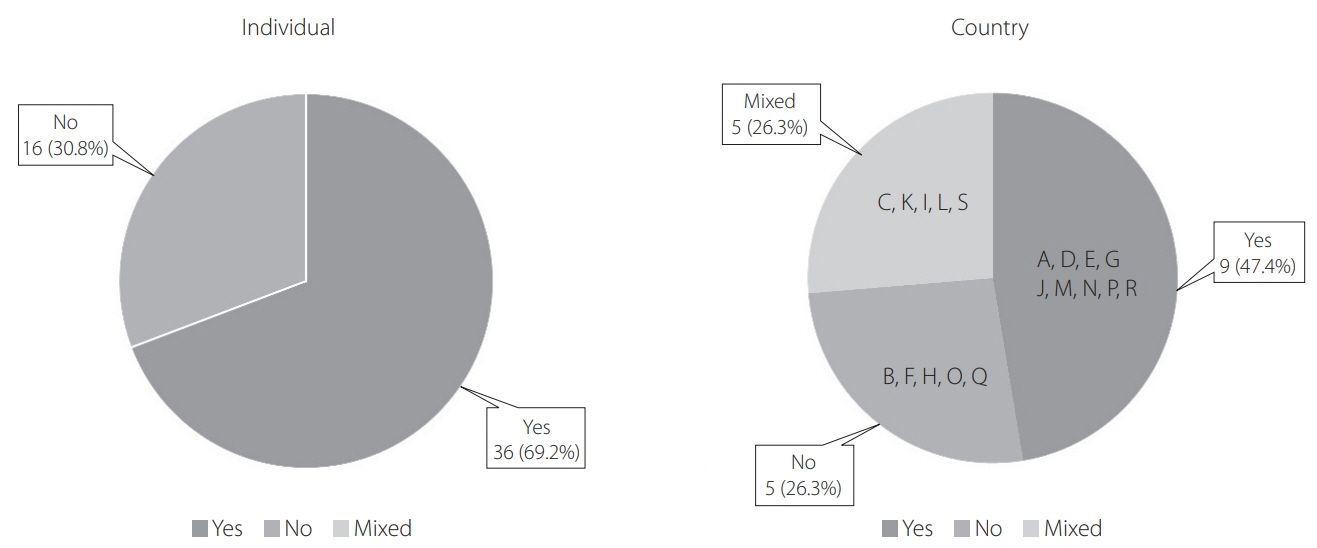Neurointervention.
2020 Jul;15(2):55-59. 10.5469/neuroint.2019.00283.
International Survey on Criteria for Training and Accreditation in Interventional Neuroradiology
- Affiliations
-
- 1Department of Radiology, Asan Medical Center, University of Ulsan College of Medicine, Seoul, Korea
- 2Department of Clinical Neuroscience, Karolinska Institutet and Department of Neuroradiology, Karolinska University Hospital, Solna, Sweden
- 3Department of Radiology and Nuclear Medicine, Amsterdam University Medical Centers (AMC), Amsterdam, The Netherlands
- KMID: 2503389
- DOI: http://doi.org/10.5469/neuroint.2019.00283
Abstract
- Purpose
With the rapid expansion of the field of interventional neuroradiology (INR) and the diverse background of aspiring neuro-interventionists, there is an ever increasing need to establish consensus criteria for training and accreditation in INR.
Materials and Methods
We performed a survey to explore the current state of criteria for training and accreditation in INR. The questionnaire consisting of 11 questions was emailed to the members of World Federation of Interventional and Therapeutic Neuroradiology (WFITN) worldwide. It was focused on the training charter, training program, qualifying examination, and education after training program as perceived by practitioners in each country.
Results
A total of 52 WFITN members in 19 countries responded to the questionnaire. There was a huge variation internationally and nationally due to the unique situation and challenges in each country and institution. Criteria for training and accreditation in INR were well established in some countries of Europe, North America, and Asia but not specified in other countries.
Conclusion
It is critical to establish consensus criteria for training and accreditation in INR in order to ensure safe practice and continued expansion and development of INR as a specialty.
Figure
Reference
-
1. Lasjaunias P. Editorial. What is the role of the WFITN with regards to the worldwide clinical practice of Interventional and Therapeutic NeuroRadiology, its world meeting and scientific challenges (research)? Interv Neuroradiol. 2007; 13:311–313.2. Picard L. Interventional neuroradiology training charter. Interv Neuroradiol. 2009; 15:11–15.
Article3. Flodmark O, Grisold W, Richling B, Mudra H, Demuth R, Pierot L. Training of future interventional neuroradiologists: the European approach. Stroke. 2012; 43:2810–2813.4. Zhao LB, Miyachi S, Shi HB, Suh DC. Comparison of medical education and requirements for training in the interventional neuroradiology in China, Japan and Korea. Neurointervention. 2013; 8:3–8.
Article
- Full Text Links
- Actions
-
Cited
- CITED
-
- Close
- Share
- Similar articles
-
- Perspectives on Fellowship Training Standard in Interventional Neuroradiology
- Comparison of Medical Education and Requirements for Training in the Interventional Neuroradiology in China, Japan and Korea
- Analysis on the Performance and Tasks of Accreditation System for Medical Colleges
- Anesthetic Consideration for Neurointerventional Procedures
- Erratum: Susceptibility Vessel Sign in the ASTER Trial: Higher Recanalization Rate and More Favourable Clinical Outcome after First Line Stent Retriever Compared to Contact Aspiration




